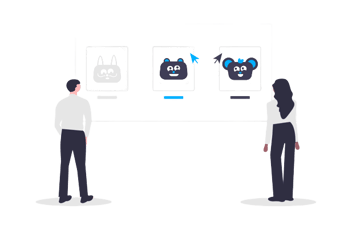Customer feedback survey template
Developing a customer satisfaction survey is a great way to uncover what customers love about you, and where you can improve. Creating the survey itself, however, can be time-consuming and challenging. Are you asking the right questions? Are you asking too many? How can you optimise the survey to uncover some great insights for your business?
To uncover the journey your customers go through, you can ask questions strategically. Surveys help you retain and acquire new customers but you don’t want to put that responsibility on their shoulders. It’s your job to ask the right questions to achieve the most helpful insights.
To help you build your customer feedback survey we’re going to outline a few key questions you can ask and a structure to follow. Let’s begin!
Customer feedback survey rules
When building your customer satisfaction survey there are a few golden rules you should follow to get the best results possible.
Open and closed questions
Understanding the difference between open and closed questions will help you construct the question to suit the answer type you’re after. But what’s the difference between the two?
- A closed question would garner a yes or no answer.
- An open question encourages elaboration.
A closed question example would be: “Did you floss today?”, an open question would be “Why is flossing important?”.
Leading questions
A leading question guides the customer to a certain response. These questions can be very influential in a customer survey. These sound more like statements that seek affirmation than actual questions. An example may include: “Your experience with us was satisfactory, correct?” or “There were no negative aspects of your experience with us, were there?”
Loaded questions
These imply a fact that hasn’t necessarily been established as true. By answering the question, your respondent confirms the assertion you’ve made, even though they may not have provided that information themselves. An example may include: “Your previous supplier was unsatisfactory, how much better is our service?”
Customer feedback survey template
Now that we’ve covered some basic rules we can share with you a few examples to get you started. We’ll focus less on the design and more on the questions themselves.
Service satisfaction template
The purpose of a service satisfaction survey is to highlight where you met, exceeded or fell short in servicing that customer’s needs. These are generally used when a customer has engaged with the customer service team or has had a non-sales communication with the company. Questions that can be asked include:
- How would you rate the quality of service you received today? [Use a 1-10 sliding scale].
- How would you rate the speed at which the issue was resolved? [Use sliding scale or drop-down].
- As a result of this experience do you now have a more positive or negative perception of the company? [Drop-down].
- Is there anything we could have done to make your experience exceptional? [Free text response].
- What was the most memorable aspect of your service experience with us? [Free text response].
With all of the above questions, you can have a dependent field that asks for additional information if you wish.
Product satisfaction survey template
A product satisfaction survey seeks to identify improvements that can be made to a product or the customer’s use of the product. It can work best to check that the reality met the marketing promise and that there are no quality control issues that need to be ironed out.
- What features do you value the most about this product? [Shuffler or free text]
- Has this product met your expectations? [Drop-down]
- What would you improve about this product? [Free text]
- How likely are you to recommend this product to someone else? [Sliding scale or drop-down].
- What other products did you consider buying before choosing this one? [Free text].
- How would you rate the build/finish quality of the products [Use a 1-10 sliding scale].
The shuffler type response enables you to list a number of features and have the user rearrange them in the order they find most appropriate.
Experience satisfaction survey template
An experience satisfaction survey is similar to the product satisfaction survey but cares less about physical attributes and more about emotional/psychological. With this survey type, you might focus more on the sentiment expressed about the experience and the lasting impression it has left.
- What was the best part about your experience with us? [Shuffler or free text]
- Did the experience meet your expectations? [Drop-down]
- What would like to see changed about the experience? [Free text]
- How likely are you to recommend this experience to someone else? [Sliding scale or drop-down].
- How did you feel before the experience, and how did you feel after? [Free text or Shuffler].
- Would you do it again and why? [Free text].
In all of the above feedback survey templates the questions are:
- Specific
- Clear
- Incisive
- Valuable
Each makes it possible for the business to see what they’re doing well and opens up insights that only a customer can offer. These can then be used to improve the business, or help to attract new customers. It’s important to note that while it’s tempting to ask as many questions as possible there is a fine line between being curious and taxing on the respondent.
To start with, why not pick 5 essential questions that will really help you get a sense of what the customer is experiencing. You can always add more if you find there’s a good response rate. To improve your customer feedback process with intuitive and simple software try Review Tui. Launching later this year you can register your interest and be the first to find out more by clicking the button below.



